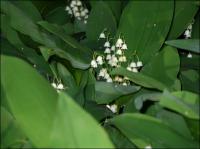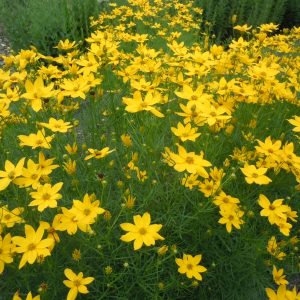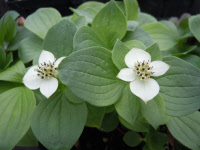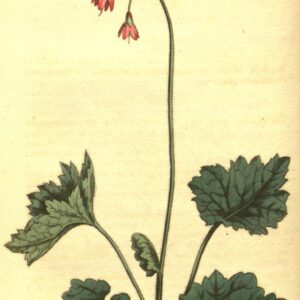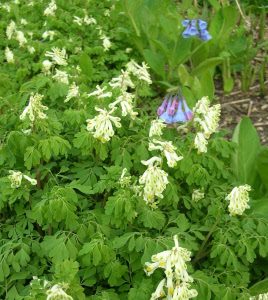Perennials & Biennials
Showing 113–120 of 484 results
-
Clematis occidentalis var. occidentalis Purple clematis. Short-styled bluebell Z 4-8
Four petaled (sepals), purple, down-facing, 4” long bells flowering in spring encircling a bundle of styles and stamens.
OUT OF STOCK – EMAIL FOR AVAILABILITY
Four petaled (sepals), purple, down-facing, 4” long bells flowering in spring encircling a bundle of styles and stamens.
Size: 3-12” x 2’
Care: sun to shade in moist well-drained to well-drained, alkaline soil
Native: Maine to Minnesota south to Illinois and South Carolina and all states between, Wisconsin native. Endangered in three states; “of special concern” in Wisconsin and gone in Ohio.The species first described by Danish botanist Jens Wilken Hornemann in 1805. var. occidentalis is the eastern variety of the species (peculiarly called occidentalis meaning west.) The species and other varieties are native in western US.
-
Convallaria majalis Lily of the Valley Z 2-7
Classic - dainty alabaster white bells perfume the air in spring. Frangrance unmistakable.
Classic – dainty alabaster white bells perfume the air in spring. Fragrance unmistakable.
Can not ship to: Maryland
Size: 9" x Spreading.
Care: sun to shade in moist or moist well-drained soil.
Native: north temperate zones in the world.
Size: Makes a great groundcover under trees.Convallaria is Latin meaning “valley.” Majalis means “May flowering.” Lily of the valley has been cultivated since at least 1000 B.C. The Norse goddess of dawn adopted it as her special flower. According to legend the plant first appeared at the spot where St. Leonard shed blood while conquering the dragons. Grown in the garden of Johann Konrad von Gemmingen prince bishop of Eichstätt in Bavaria, c. 1600. 17th century herbalists used Lily of the Valley to improve memory and strengthen the heartbeat. Robert Louis Stevenson reported medicinal uses in Kidnapped: “for sprains, rub it in; and for the cholic, a greate spooneful in the hour.” Pink flowered varieties, striped and variegated ones grew in the 1500’s. Grown by Jefferson at Monticello. Pressed specimen in Emily Dickinson’s herbarium.
-
Coreopsis lanceolata Lanceleaf tickseed Z 4-9
Golden yellow daisy-like flowers with pleated petals, jagged at their tips, June to September
OUT OF STOCK
Golden yellow daisy-like flowers with pleated petals, jagged at their tips, June to September
Size: 24” x 18”
Care: sun to part shade, moist well-drained soil
Native: Central and southeastern U.S., WI native
Wildlife Value: caterpillar food sourceCoreopsis is Greek meaning “buglike” referring to the seeds looking like little black bugs. Cultivated in America since the 1700’s. Sent to England in 1724 by English naturalist Mark Catesby (1683-1749).
-
Coreopsis verticillata Thread leafed tickseed Z 4-9
All summer into fall, free-blooming non-stop - yolk yellow daisies of 8 narrow spoon-shaped petals with a color matching center each atop a wiry stem. Cut back half-way to promote reblooming in fall.
All summer into fall, free-blooming non-stop – yolk yellow daisies of 8 narrow spoon-shaped petals with a color matching center each atop a wiry stem. Cut back half-way to promote reblooming in fall.
Size: 24" x 18" spreading
Care: Sun to part shade well-drained to moist well-drained soil, drought tolerant
Native: S.E. U.S.
Wildlife Value: attracts butterflies, Deer resistantNatives made a tea with the roots to remedy diarrhea and induce vomiting and a tea with the plant tops to make blood strong. A drink made from boiling the entire plant was used to remedy internal pain and bleeding. Also made a red dye and a yellow dye. Exported from its native America to England in 1759.
-
Cornus canadensis Bunchberry, Creeping dogwood Z 2-7Cornus canadensis syn. Chamaepericlymenum canadensis Bunchberry, Creeping dogwood Z 2-7
Four white, pointed petal-like bracts in spring and showy scarlet berries in fall
Four white, pointed petal-like bracts in spring and showy scarlet berries in fall
Size: 6” x spreading slowly
Care: part shade in moist, ACIDIC soil. Needs moisture to establish
Native: Northern areas from the east to the west coasts of No. America, Wisconsin native.
Wildlife Value: Host for the caterpillar of the Spring azure butterfly. Pollen and nectar for many bees, wasps, ants, butterflies and beetles. Deer and rabbit resistantFlowers open faster than any other flower, in less than ½ millisecond. Abnaki Indians used it to cure side pains. Algonquin made a cathartic tea, cured colds, and stomach aches with this. Delaware reduced body pains with it. Chippewa, Cree and Eskimo smoked the berries. Probably 1st collected for gardens by John Bartram (1699-1776). Offered for sale at his nursery near Philadelphia. Sent to Dr. Fothergill in London in 1774. “One of the prettiest plants for the bog garden or the cool parts of the rock garden.” William Robinson 1899. Pressed specimen in Emily Dickinson’s herbarium.
-
Cortusa matthiola syn. Primula matthioli Alpine bells Z 4-9
Demure purple, drooping bells atop a short scape arising from a low carpet of foliage in May-June.
OUT OF STOCK
Demure purple, drooping bells atop a short scape arising from a low carpet of foliage in May-June.
Size: 9” x 10”
Care: shade to part shade in moist soil
Native: AlpsDiscovered in a valley near Vincenza Italy in the foothills of the eastern Alps by Padua botany professor J.A. Cortusus. His friend Mattioli (1500-1577) named it for him and the species was named for Mattioli. According to Mattioli women used the leaves to color their cheeks pink: “the leaves applied to the cheeks, and shortly removed, occasion a beautiful colour, resembling that from the finest rouge. . .” Gerard grew this in London in the 1590’s but it was “at all times rare.” Profiled in 1807 in Curtis’ Botanical Magazine, plate 987
-
Corydalis lutea syn. Pseudofumaria lutea Yellow fumitory, Z 4-8
Clumps of canary yellow narrow tube-shaped flowers with flared ends bloom over mounds of ferny foliage from late spring – fall. Longest blooming shade flower
Clumps of canary yellow narrow tube-shaped flowers with flared ends bloom over mounds of ferny foliage from late spring – fall. Longest blooming shade flower
Size: 9-15" x 18"
Care: part shade to shade in moist well-drained to well-drained soil
Native: Throughout EuropeCorydalis is Greek for “lark” korydalos, referring to the shape of flower, a lark’s spur. Lutea means “yellow.” According to 16th century herbalist Culpepper, “Saturn owns the herb” so Corydalis lutea cured Saturn’s diseases of the liver, spleen, leprosy, scabs, itches, cholera, salty blood, jaundice, melancholy, plague, pestilence and red eyes. Greek physician Dioscordes authored 5-volume De Materia Medica writing that this “hinders fresh springing of hairs on the eye lids.”
-
Corydalis ochroleuca syn. Pseudofumaria alba Z 4-8
Clumps of crem white with a touch of yellow, narrow, tube-shaped flowers with flared ends bloom over mounds of ferny foliage from late spring – fall. One of longest blooming flowers for shade.
Clumps of cream white with a touch of yellow, narrow, tube-shaped flowers with flared ends bloom over mounds of ferny foliage from late spring – fall. One of longest blooming flowers for shade.
Size: 6-12” x 12”
Care: Shade to part shade in well-drained soil
Native: BalkansCorydalis is Greek for “lark” korydalos, referring to the shape of flower resembling a lark’s spur. This species published in 1831. Gertrude Jekyll (1848-1931) planted Corydalis ochroleuca as a “wide carpet” under peonies in her spring garden at her home, Munstead Wood.


